LIFECYCLE
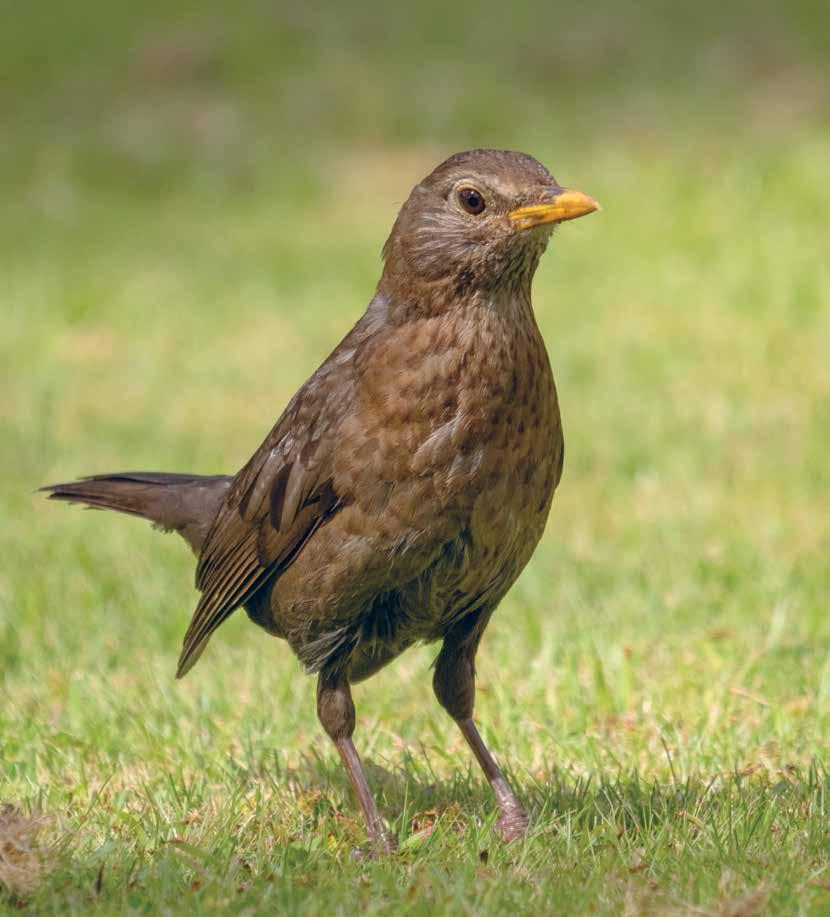
Blackbirds
Investigating recent declines
Editorial ISSUE 16 AUTUMN 2025

Welcome to the autumn edition of LifeCycle. As we sit here at BTO HQ putting the finishing touches to this edition, it is easy to forget how lucky we are to be located on the edge of a rural town, with the BTO reserve next door. The regular posts from staff to the reserve WhatsApp group notify us of anything unusual that has dropped in (be that avian or otherwise). The reserve also plays host to ringing and nest-recording activities. The ringers there are still waiting to encounter a true rarity, but if you were lucky enough to catch a first for Britain or Ireland in your nets, would you know what to do to ensure you collect the necessary information for the BBRC or IRBC? If not, the article on page 28 should help you prepare for such an eventuality. Not everyone has a reserve on their doorstep though. If you live in the middle of a city and want some inspiration for urban ringing, Paul Baker’s article on ringing in Glasgow (page 19) might be just the thing.
With the recent population expansion of Cattle Egrets, more of us might be fortunate enough to find them nesting alongside Little Egrets, but how do you tell the chicks apart? Kieran Foster reveals all on page 24. While rarities are exciting, we shouldn’t forget (or stop monitoring) our more-common species. If you have noticed fewer Blackbirds in your garden of late, this could be down to a newly emerging disease – read more on page 16. Elsewhere, you can find out how to age Dipper chicks (page 5), read about a Rock Dove RAS (page 10), find out how you can get more involved with monitoring raptors in Wales (page 8) and much more.
We couldn’t publish this magazine without you, so huge thanks to all the contributors for sharing their stories, projects and knowledge.
Ruth Walker & Lee Barber
LIFECYCLE
THE BTO MAGAZINE FOR RINGERS AND NEST RECORDERS
The Ringing and Nest Record schemes are funded by a partnership of the BTO and the JNCC on behalf of the statutory nature conservation bodies (Natural England, Natural Resources Wales, NatureScot and the Department of Agriculture, Environment and Rural Affairs, Northern Ireland). Ringing is also funded by The National Parks and Wildlife Service (Ireland) and the ringers themselves. The BTO’s contribution to the Ringing Scheme is supported by funding from Gifts in Wills, for which we are extremely grateful. The BTO supports ringing and nest recording for scientific purposes and is licensed by the statutory nature conservation bodies to permit bird ringing and some aspects of nest recording. All activities described are undertaken with appropriate licences and following codes of conduct designed to ensure the welfare of birds and their nests is not adversely affected.
CONTACT US
The British Trust for Ornithology is a charity dedicated to researching birds. For membership details please contact: membership@bto.org
British Trust for Ornithology, The Nunnery, Thetford, Norfolk IP24 2PU Tel: (01842) 750050 Website: www.bto.org Email: ringing@bto.org
Registered Charity no 216652 (England & Wales), no SC039193 (Scotland)
LIFECYCLE
PRODUCTION
LifeCycle is the biannual magazine of the BTO Ringing and Nest Record schemes. It is freely available on the BTO website at: www.bto.org/lifecycle.
Articles in LifeCycle are written by ringers and nest recorders, so please send ideas and contributions to the editors: Lee Barber — email: nrs@bto.org Ruth Walker — email: ruth.walker@bto.org
Editorial board: Ruth Walker, Lee Barber, Mark Grantham, Ros Green, Peter Kirmond, Joe Morris, Justin Walker and Ellie Leech.
Layout, design, imagesetting and typesetting: Ruth Walker and Mike Toms. Printing: Rollmark Ltd https://rollmark.co.uk/
Thanks to the proofreaders for all their efforts. Cover image: Blackbird, by Edmund Fellowes / BTO The views expressed by the contributors to this magazine are not necessarily those of the Editors, the Board of the BTO or its committees. Quotations should carry a full acknowledgement. © BTO 2025
NEWS FROM RINGING & NEST RECORDING
RUTLAND WATER RINGING GROUP
Rutland Water Ringing Group is looking for ringers to join and support some of their ongoing projects. “We have two Constant Effort Sites, two artificial Sand Martin banks, a Sand Martin RAS, 25 large-hole nest boxes, several tern rafts, and several other productive general mist-netting sites around the nature reserve, but at the moment we lack the people power to cover all these activities. Rings are free, net rides are maintained by the Wildlife Trust, and nets and equipment can be provided by the ringing group. What’s not to like! We cannot currently take trainees but can welcome C-permit holders and above with endorsements that cover our activities.” If interested, please contact Sam at: s_miller08@outlook.com
FILEY BIRD OBSERVATORY
S- or A-permit holders, or experienced C-permit holders, are needed to help maintain the ringing programme at Filey Bird Observatory. A number of sites are available in the Obs area for mist netting and dazzling, including the Country Park Top Scrub, the Helgoland Trap/Old Tip area, Parish Wood, East Lea and Filey Brigg. Key times of the year are April to May and July to November for migrant warblers, petrels, winter thrushes as well as passage waders and terns. For more information, please contact Lucy at: lucy.murgatroyd@naturalengland. org.uk
COLOUR-RINGED GREYLAG GEESE
On 18 July 2025 Tay Ringing Group caught and neck-collared 14 Greylag Geese at Loch Leven. These are the first Greylag Geese to be neck-collared in Scotland for many years and are part of a study to try and better understand the extent of overlap in Icelandic and feral/re-establishing Greylag Geese populations. Birds have subsequently been reported moving to Tyninghame, East Lothian and the Bow of Fife. The birds were also tested for Avian Influenza by NatureScot, and
Tay Ringing Group is very grateful for the support of the Loch Leven NNR team and the HPAI team in ensuring a successful catch. The neck collars are orange with black letters, and any sightings should be sent to Les Hatton at: les@edenecology.co.uk
MAKING THE MOST OF THE RINGING EXPERIENCE MAP
It’s easy for ringers and groups to become ‘siloed’, where T- and C-permit holders only learn the techniques and methods that their Trainer or group regularly uses. It can be difficult to diversify, as there’s often no way to know who’s doing what near to you, or where to go for extra experience. Until now that is…
Over the autumn we launched the Ringing Experience Map, which allows ringers to seek out experience of some of the less-routine ringing experiences. We hope that the map will allow people to expand their experience away from the standard ‘passerines in mist nets’ on most people’s permits.
If you’ve not yet added your details to the Ringing Experience Map then please do so, as the more ringers that populate the map the more useful it will become. To do this, just log in to your ‘My BTO’ account and update your own map details to offer others
the opportunity to learn from you. Further instructions of how best to populate the map (including which keywords to use) are on the Ringing Hub and in the email sent out earlier in the autumn.
BTO RESEARCH GRANTS
BTO ringers are eligible to apply for a BTO Research Grant of up to £500. Grants are awarded to projects focusing on any aspect of field ornithology, particularly those most relevant to the BTO’s core research activities.
Preference is given to research carried out in Britain, Ireland and other parts of the Afro–Palaearctic flyway and priority will be given to well-designed research projects that are likely to produce publishable results. Projects undertaken by amateurs will be prioritised; however, collaboration with professionals, including BTO staff, is encouraged.
Student projects are unlikely to be funded under the BTO Research Grant scheme, but the committee may exceptionally award grants to projects that are inadequately supported from educational sources.
The closing date for applications is 15 December 2025. Find out more at: www.bto.org/our-work/science/ research-grants
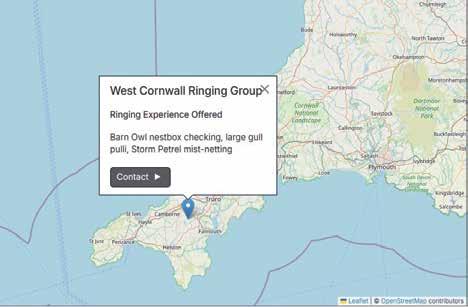
Nurturing fledgling nesters
Three nest-recording taster days were held this year, providing the participants with a valuable training opportunity. We asked the organisers of those days, Ben Darvill , Mark Nowers and Stephen Hewitt , to summarise what went well and what others should consider if they want to organise a similar event.

are interested
at: nrs@bto.org
As with running any training session, preparation is key to ensure that everyone involved gets the best out of the session. There are always challenges with training people in the field but, hopefully, the following information will help you overcome these and run an informative session that gets people engaged and eager to find and monitor nests themselves.
PREPARATION
Keep it simple. Choose a location that you are familiar with, where you know it will be easy to find a range of nests and have a clear itinerary for the day, with structured breaks. Selecting a date in late May means attendees will have a wide range of species and nest stages to learn from while still leaving time for them to deploy their newly acquired skills early in the nesting season. It is very important to know your site well! Before the session, make sure you have received permission from the landowner to carry out the taster day (as there will be more people present than during regular nest-recording activities). If your chosen patch doesn’t have toilets on site, identify nearby public toilets and structure the day to ensure people can access them.
WHAT WENT WELL
During the session, show the attendees a range of nests. Explain how each was found and demonstrate different nestfinding techniques. While doing this, ensure that the NRS Code of Conduct is followed and explain to the attendees how you are following it. Discuss what information should be recorded, and how, including showing them how to inspect the nest contents with a mirror on a stick or an endoscope if available. Provide attendees with plenty of opportunities to ask questions and consider inviting another knowledgeable person along to help answer these. Tea breaks are a great way to break up the session and prompt more informal chats and questions about nest recording. You can either provide basic tea- and coffee-making facilities or ask attendees to bring their own flasks.
OVERCOMING CHALLENGES
With bigger groups, you may be asked a lot of questions throughout the session. Running through what you want to say, identifying nests and keeping to your itinerary can be a lot to juggle, so it will be helpful to have multiple experienced people on hand to help. It can also
be helpful to have someone there specifically to help cover logistical and administrative tasks.
If you’re keen to give this a go, one option is to start small and limit numbers to 4–5 attendees. That’s an easy group size to manage and allows you time to chat and support them individually. If you’d prefer to run something larger, 10–12 is probably a sensible maximum group size. In this case it would be wise to get help from at least one other experienced nest recorder. BTO can advertise taster days or weekend courses on their website to help you find attendees.
It is important to keep attendees engaged after the session, and encourage them to carry out nest recording longer term. One way to do this is to ask if anyone would like to be added to an informal WhatsApp group at the end of the session. You can use this to post updates on nests you find later on in the spring, and for them to share what they’ve found and ask any questions. This will also give them a place to chat about what they want to focus on when they return home, whether it be single-species studies or targeting one or more sites, and a safe space to ask for advice.

More information about monitoring Dippers can be found in the article ‘Dabbling with Dippers’, published in the Spring 2016 edition of LifeCycle (www.bto.org/lifecycle).
Ageing Dipper chicks
In 2019, Rachel Steenson started a PhD that explored the environmental basis for population change in riverine birds. Perhaps the part that she was most excited about was the opportunity to spend three full breeding seasons monitoring Dippers at various sites around Scotland. As with all best-laid plans, however, things didn’t completely go to plan! In this article, Rachel presents a guide to ageing nestling Dippers based on the data she collected during her PhD research.
After months of planning, I set out eagerly in early 2020 to find territories and nests, only for my search to be cut short by a global pandemic! Slightly worried that I’d lost not only a year of data, but also precious time to learn and make mistakes, I reached out to members of my ringing group for advice. In autumn, I spent multiple days out around Dundee ringing Dippers with Mike Nicoll and the late Kenny Slater of Tay Ringing Group, interrogating them for any and all information gained from decades of nest recording and ringing. With their guidance, and some location-specific advice from Jeremy Wilson, I set out on my second field season with renewed enthusiasm and a plan: record everything, take photos as references and talk to locals to ask what they’ve seen along the river.
Over the course of two years, I spent multiple days a week visiting nests in a 28-km section of river in Midlothian and collected a bounty of evidence to capture the development of young in the nest. This is a tiny fraction of the expertise of some nest recorders; however, I hope that this ageing guide provides a visual reference of pullus development for nest recorders and
ringers alike, making it easier to identify that golden window of time when it is safe to visit the nest.
DIPPER NESTING HABITS
Nest building generally occurs between early January and March, depending on location and weather. Nests are mostly located directly above moving water, on both man-made structures (e.g. culverts, bridge supports) and natural sites (e.g. vertical rock walls, overhanging banks). Egg-laying occurs from late February for first clutches, but second or replacement clutches can be laid into June. Clutches contain an average of four or five eggs, with one laid each day, and nestlings hatch 16–17 days after the penultimate egg is laid. Chicks fledge an average of 18–22 days after hatching, and will remain in the vicinity of the nest for a period of weeks, but may be ushered out of the territory if the breeding pair has a subsequent breeding attempt.
VISITING DIPPER NESTS
As chicks age, their features follow a simple progression that can be matched to their ‘day of life’. Whether for nest-recording
PHOTOGRAPHS
All photos were taken by Rachel Steenson during visits for nest-recording or ringing purposes. Great care was taken to minimise disturbance and contact time with pulli.
or ringing purposes, nests are generally safe to visit up until day 13 or 14 of pulli being in the nest. From this point, pulli response towards threats changes from ‘hide’ to ‘flee’, and the risk of premature fledging significantly increases. Nests should therefore not be approached when pulli are day 14 or older, and great caution should be taken when visiting a nest of unknown contents from mid-March onwards. Conducting weekly nest checks, or estimating forwards from known events
WINGS
(e.g. clutch initiation), can minimise disturbance, whilst identifying the key windows for pullus ringing (day six to 12) or avoiding the nest until fledging (day 14+). As Dipper nests are fairly fragile, care should be taken during nest checks when reaching inside to ensure you don’t detach the nest from its supporting surface. Estimating age by touch alone requires some experience, but a borescope provides a good view of nest contents with minimal disturbance to chicks.
Wing development provides the clearest method for estimating age. On day one (hatch date) and day two, pulli have small pink wings that are often held away from the body. On day three, a thin grey line may be visible along the wing, developing into a thicker grey stripe by day four, indicating the development of feathers below the surface of the skin. By day six or seven, short soft ‘pins’ are often visible, and these develop rapidly (Figure 1).

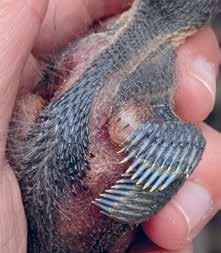
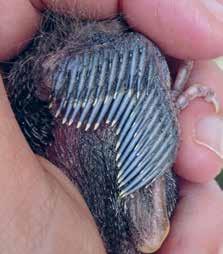
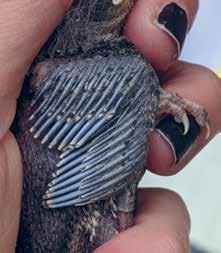
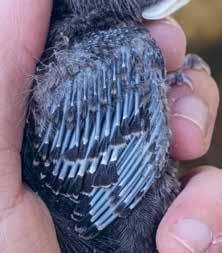
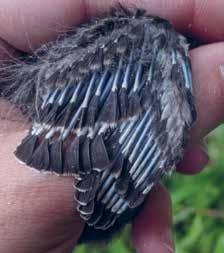
BODY FEATHERING AND EYES
Pulli are pink on hatching, but quickly develop grey patches on their back from day four onwards. Feathers begin to emerge from these patches from day six or seven and continue to fill in across their back. A similar progression occurs on their belly, with a gradual infill of pale-yellow feathers towards the centre (Figure 2). Eyes open from day six, but are likely held shut against bright light until day 10. By day 12 pulli loosely resemble fledgling appearance.


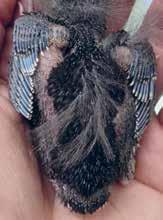
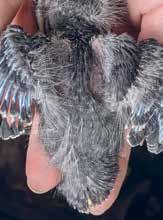

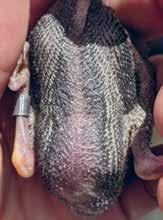
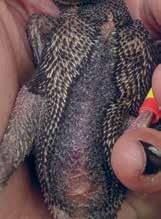
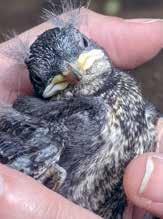
FEET & TARSUS
Foot and tarsus development is best identified through the colour shift from pink to grey and the improvement in grip strength (Figure 3), but there is a lot of variation. Claws are present from hatching, and toes are noticeably longer by day five or six. Pulli are generally large enough to take a ring by day six, but checking with pliers is recommended.
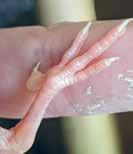
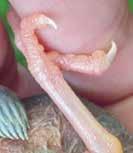



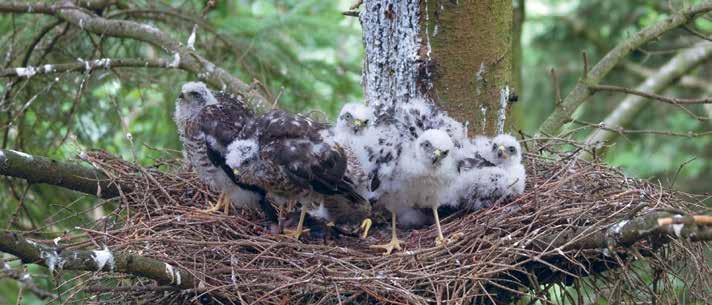
Boosting raptor monitoring in Wales
Monitoring bird populations is central to the BTO’s work, helping us understand long-term trends and providing critical data to inform policy and conservation. Among the many bird groups we track, birds of prey are particularly important, thanks to their residence at the top of the food chain. Here, Charlotte Griffiths , BTO’s Welsh Raptor Monitoring Coordinator introduces Cudyll Cymru, a Welsh monitoring initiative which monitors the populations and breeding productivity of five widespread raptors.
Raptors serve as effective umbrella species, meaning that efforts to understand and protect them often benefit a wide range of other wildlife. Demographic data are particularly useful in this regard, because variation in the survival and productivity rates of predators can be an immediate reflection of the changing fortunes of their prey. Yet despite their importance, raptors are among the more challenging species to monitor, leaving substantial knowledge gaps that impact the conservation of these iconic species.
CUDYLL CYMRU
Cudyll Cymru is roughly translated as ‘Falcons Wales’, and is pronounced "kid-ith come-ree".
The Welsh name for Buzzard is Bwncath.
The Welsh name for Red Kite is Barcud Coch
Raptors are sparsely distributed and behave in ways that make them difficult to observe with conventional survey techniques. Lack of early-morning activity means they may be overlooked during surveys for the BTO/JNCC/RSPB Breeding Bird Survey, and even common species can prove elusive. Nests can be hard to locate, even for widespread species like Sparrowhawk, and some species breed almost exclusively in remote upland areas. Many species have the additional requirement of a Schedule 1 permit, which is an additional barrier to overcome for those interested in getting involved in nest
recording. Monitoring them effectively therefore demands specialist skills and knowledge, which can only be gained through practical experience in the field; however, their ‘rock star’ charisma presents a unique opportunity to inspire and engage new audiences in bird monitoring.
THE WELSH SITUATION
In Wales, these challenges are particularly acute. Currently, Buzzard and Red Kite are the only raptors with published BBS population trends for the country. Demographic data are similarly sparse, and those data are collected by a small pool of raptor workers. An average of just one Sparrowhawk nest record has been submitted per year from Wales since 2007. Around 60% of all 2023 Welsh nest records for Red Kite came from a single recorder, with a similar level of reliance for Kestrel upon the work of the Mid Wales Ringing Group.
The contributions of these supervolunteers are incredibly valuable, but our long-term datasets are highly vulnerable to any reduction in their ability to carry out monitoring: we have seen the number of
Buzzard nest records in Wales dwindle from 66 in 2007 to just seven in 2023.
In an attempt to tackle some of these challenges, BTO launched Cudyll Cymru in October 2024. The project focuses on five common and widespread species: Buzzard, Kestrel, Red Kite, Sparrowhawk and Raven (included because of its ecological similarity to raptors). Beyond gathering high-quality data, we hope that the initiative will provide new volunteers with opportunities to learn skills and gain experience, helping us to build a resilient network of confident and capable volunteers across Wales.
THE RESPONSE SO FAR
The response has been extraordinary. More than 750 people have signed up so far, many entirely new to BTO and bird surveying, a core aim of the project. Entrylevel volunteers began conducting monthly Vantage Point Counts to hone their field skills and identification abilities in March 2025. In-person training led by some of Wales’ most experienced raptor experts, many of them long-standing ringers and nest recorders, has inspired participants and boosted their confidence. One volunteer reflected: “After just three hours, I left feeling far more confident in identifying the five species and excited to start surveying my area.”
As volunteers build experience, they’ll be coached and encouraged to progress to higher-level tasks, such as mapping behaviours indicative of breeding activity, associating records with specific breeding pairs and ultimately, for some, recording nests. As the BTO’s first-ever Raptor Monitoring Coordinator for Wales, I provide hands-on support through training, field sessions, and one-to-one ‘survey surgeries’ to help volunteers master survey techniques and the dreaded data entry!
Bilingual training resources, videos, and a range of future workshops, covering skills like identifying raptor signs and nest finding, are helping to deepen participants’ knowledge. The commitment to providing Welsh-language resources has been crucial in engaging local communities and celebrates the cultural heritage of Wales.
To celebrate this pioneering project and the valuable data generated, we are
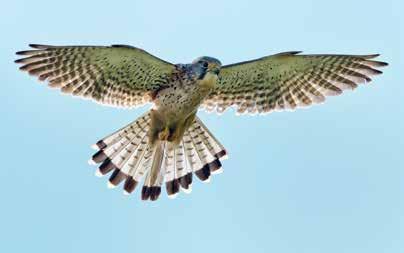
preparing to hold the first Welsh Raptor Conference this coming January. We hope the event will foster a sense of community amongst our volunteers, giving them the chance to network with like-minded people and learn from more-experienced peers.
THE FUTURE
Looking ahead to 2026 and beyond, we’re excited to develop a network of volunteer experts to provide support to those aiming to start monitoring nests or even train as raptor ringers. We also warmly encourage existing nest recorders and ringers across Wales to get involved by signing up via their My BTO account and reaching out for a chat. We’d particularly like to hear from raptor workers who may be willing to share their knowledge and experience with newer volunteers. In the longer term, we hope that many of the volunteers currently cutting their teeth through Cudyll Cymru will progress to monitoring scarcer raptor species.
Though the full impact of this project won’t begin to become clear until the first season’s data are analysed later this year, Cudyll Cymru has already transformed the landscape of raptor monitoring in Wales. By embracing a fresh approach and removing barriers to participation, we’ve sparked people’s interest in being part of something special. With continued support and dedication, this initiative promises not only to deepen our understanding of these remarkable birds but also to help secure their future for generations to come.
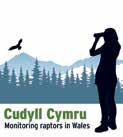
is funded by the Nature Networks Programme, delivered by the Heritage Fund on behalf of the Welsh Government.
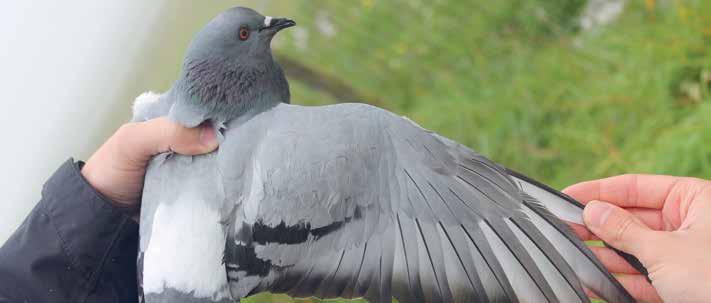
Rock Doves – a neglected species
In May 2016 Sam Bayley (now with National Parks and Wildlife Service, Ireland) became the Warden of Cape Clear Bird Observatory, located off the southwest coast of County Cork. Although he only stayed in post for two seasons, it was a fabulous opportunity and left a lasting impression, including his continued presence in Ireland. It also led to him starting a RAS project on Rock Doves, as Sam explains.
Cape Clear Island is obviously fabled for having hosted a great many rare and scarce species over the years, the majority of which rarely stay for more than a few days. I got to see and catch several such vagrants during my stint, but the first new species that I caught – within a month of arriving – was a common resident: the Rock Dove. As with catching any new species, I went straight to the newly published Baker (2016) and Demongin (2016), only to find that neither book covered this native species at all! I was also surprised to realise it was not only the first to be ringed by the Observatory, but one of only a handful ever ringed in Ireland (and not that many more in the UK!).
REFERENCES
Baker, J.K. 2016.
Identification Guide to European Non-passerines. British Trust for Ornithology, Thetford. Demongin, L. 2016.
Identification Guide to Birds in the Hand. Laurent Demongin, privately published.
At the end of 2015, just over 2,000 had been ringed through the BTO Scheme; about the same as for Yellow-browed Warbler. I had already put my sights on starting up a seabird ringing project for the Observatory, but this was a species I was going to be coming back to as obviously these birds were being completely overlooked. In 2018, I got in touch with Will Smith who was, at the time, starting a PhD on morphological and genetic differences among Rock Doves and Feral
Pigeons at Oxford University, which was hopefully going to put a shining light on the species. Over the next couple of years, I managed to get a few Cape Clear samples for his project (more on this later).
BECOMING A RAS PROJECT
In 2021 I realised I was able to devote some more time to this species, and the ideal project would be a RAS including a colour-ringing element. Not only would this provide the first information on survival in truly wild Rock Doves (versus their comparatively well-studied feral cousins), but it would also enable field sightings from around the island and hopefully elsewhere too. However, for any study I would need to catch enough birds. That first year, I was on Cape Clear every day from May to mid-November and only managed 45 birds, exclusively caught in small Potter traps permanently in place in the Observatory garden. As well as this, I was realistically only going to be able to get to the island once a month for a day or two since I was no longer working there.
Catching Rock Doves in mist nets, which I did try on a few occasions, had been
very unreliable and, whilst whoosh-netting led to some success, it proved difficult to catch a good number in one go. It was therefore necessary to develop another method. One of the island residents, Mary Cadogan, had taken up feeding birds in her garden daily. With the loss of tillage on the island, her garden became the prime location for the resident Rock Doves to come and feed. Mary was putting out a pack of porridge oats onto an old plastic garden table each morning and the birds had become used to this ritual. I initially tried placing a couple of the Potter traps on the table, but the birds did not much like going into an enclosed cage and inevitably a trap would get unsuccessfully tripped and then spook them all. So, I decided the only way was to build a big trap.
With Mary’s consent, I measured the width and length of the garden table and made a flat pack construction on the mainland that I brought over and fitted to the table in October 2021. The design I came up with was a large cage with a drop door operated by a simple guy string that could be released through Mary’s kitchen window. The cage needed to be big enough to make them feel safe in entering, and to hold decent numbers of birds at once (internal dimensions 90 cm wide x 75 cm deep x 60 cm high). The drop door had to be solid enough to hold the birds and rely on its own weight to keep closed, but light enough to be held up easily for a long period. It is held in place between two batons, with string through a simple eye hook. The weight and solid wooden frame were a slight concern if a bird was underneath when the door dropped, so a section of pipe insulation was added to soften the bottom edge. A further welfare essential was the use of plastic-coated mesh so that birds would not damage themselves against the netting trying to escape. When not in use, the door is tied up to the overhead frame.
During the first attempt, the day after construction, we caught 13 birds in one go, which was a great start. However, as we suspected, operating the trap too regularly would stop them coming. So, we now operate the trap once a month between the start of April and the end of August for the
RAS, and occasionally outside of that if I happen to be on the island.
RESULTS
The first three full years of the project, 2022–24, have produced 779 encounters of 144 individuals, mostly from within the RAS season. These encounters have come from a combination of catching with the trap and field sightings of colour-ringed birds. The 15 trapping attempts produced 361 encounters, with individual catches varying from five to 39 birds, but catches are usually around 25 birds. We have not had a single failed attempt and trapping in Mary’s garden accounts for all the newly ringed birds.
Almost 99% of the field sightings were collected by me or Mary, supplemented by five dead birds (three predated by Sparrowhawk and two hit by cars!), all of which were from the island. Initially this lack of resightings by others surprised me, but it highlights just how few birders even give this species a second glance. The project has also produced a new Irish longevity record for the species; EK55129 or ‘BH’ was only the second Rock Dove I caught on Cape Clear, ringed as an adult on 4 June 2016 and re-encountered on 31 August 2025 for the 18th time, 9 years and 2 months since ringing (making it at least 10 years old).
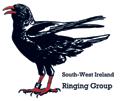
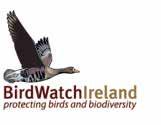
ACKNOWLEDGEMENTS
The project rings have been funded by BirdWatch Ireland’s Cape Clear Bird Observatory and Mary Cadogan. I am also grateful for the support of other members of South-West Ireland Ringing Group, who have helped with the trapping.

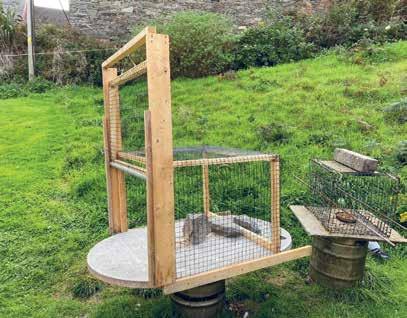
Precious genes: Rock Doves in the United Kingdom and Ireland
Whilst Feral Pigeons are one of the most abundant birds in the world, their wild Rock Dove cousins are poorly studied and globally declining. Wild–feral interbreeding across the native Afro–Eurasian range of the species has rendered their genetic status unclear. In many regions, such as England and Wales, wild-type Rock Doves no longer exist and any pigeons you see on cliffs are feral birds reverting to a similar lifestyle to their native ancestors. Difficulties in distinguishing wild, feral, and domestic individuals led to national and international population estimates lumping all forms of the species together, masking range declines and population losses of the wild Rock Doves.
The species as a whole is classified by the IUCN as being of ‘Least Concern’, despite probable feral incursion within much of its native range. Doubts regarding their genetic provenance made the Rock Doves of the UK and Ireland among our least understood native species. Starting in 2019, we have been studying putative wild Rock Dove populations at various sites across Scotland, and at Cape Clear. We showed that these populations retain their genetic distinctiveness, being different from today’s feral and domestic pigeons (including some of the oldest-known breeds). Despite this, we still identified genetic signatures of hybridisation in most sampled Rock Dove colonies, with
some (e.g. in Orkney and Caithness) being highly interbred with feral pigeons. Colonies in Scotland’s Outer Hebrides retain the most ‘wild-type’ ancestry.
We now run a colour-ringing project in Uist in the Outer Hebrides, complementing the Cape Clear RAS study. In Uist, we focus on doves at roost sites and have ringed just over 1,000 individuals since 2019 by catching them at night in derelict buildings and caves. Together, all this monitoring and research is vital to build up a picture of the basic biology of Rock Doves. From their survival to dispersal and behaviour, we know incredibly little about these birds and long-term effort is required if we are to unlock their scientific and conservation value.
Work being done in the UK and Ireland will hopefully be replicated in other parts of the native range of the Rock Dove (e.g. in Mediterranean colonies), to try and identify and study other genetically distinct wild-type populations. In the long term, conservation action to maintain wild Rock Dove populations, possibly involving monitoring for Feral Pigeon incursions and removing individuals when required, may be necessary. Any such activities would need to be backed up by high-quality data, highlighting the value of ringing effort focusing on these enigmatic birds.
Will Smith, now at the University of Nottingham, School of Life Sciences

Safeguarding young people in ringing
The Ringing Scheme is committed to the training of the next generation of young ringers, and it is crucial that we do so in a safe way. For the past few years BTO has helped to ensure the safety of under-18s in the Ringing Scheme by developing robust safeguarding policies, that all ringers are required to be familiar with, and requiring Trainers of under-18s to hold a Young Person Training Endorsement (YPTE), now renamed the Young Person Teaching Endorsement. In this article, Mark Grantham and Joe Morris outline some recent changes to the way we enable the training of under-18s.
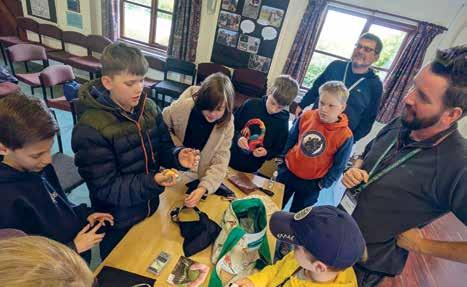
By creating the YPTE for Trainers, BTO were complying with legislation to ensure that appropriate checks had been completed (such as Disclosure and Barring Service checks (DBS) in England and Wales and their equivalent in the other countries). The use of the endorsement, and our wider safeguarding policies, ensures that we can continue to offer young people a route into the Ringing Scheme while making sure that BTO complies with its legal responsibilities, and that we provide a safe and welcoming experience for under-18s.
Despite this working well, with legislation changes it became clear that we needed to account for situations where sessions were being led, or training was being provided, by someone who did not hold an S permit. Under the current legislation, anyone providing teaching, training or instruction to an under-18, and who also meets certain contact thresholds, requires a records check. These contact thresholds are:
• once a week or more, or
• on four or more days in a 30-day period, or
• overnight (between the hours of 2 am and 6 am)
To facilitate this, we have updated the name of the endorsement to the Young Person Teaching Endorsement, and it is now available to all ringers who may be providing training to under-18s.
Even with this clarification, ringing activity presents a lot of situations where it is not necessarily obvious whether this applies. More details can be found on the BTO website under Safeguarding in Ringing, but below are a few Frequently Asked Questions.
Do I need a YPTE if the young person’s parent/guardian is present?
Yes. If the other thresholds are met, having a parent or guardian present makes no difference to the requirement for a records check. The only situation where this makes a difference is if the person providing the training is the parent or guardian, or a direct family member.
I lead sessions with young people, but they are unlikely to meet the contact threshold.
For a records check to be completed, there needs to be a presumption that you will be meeting the criteria to require the check; however, if you want to be on the safe side, get in touch with the Licensing Team and they will be able to advise. Alternatively, you might
want to consider recommending to the young person or their parents that they only attend up to three sessions per month (for example).
An under-18 has turned up with their parents for an overnight session. What should I do?
Don’t worry! The legislation makes an exception for ‘incidental’ training. If the training is being provided to their parents, and the young person is simply present, there is no need to hold a YPTE. Just ensure that no one is providing training directly to the under-18 (other than their parents).
I am ringing next to an under-18 and want to provide advice. Can I?
As above, the exception for ‘incidental’ training means that a check is not required. As long as the person providing the bulk of the training, or leading the session, has a records check, it is totally acceptable for you to provide some words of advice or encouragement.
How much does it cost to receive a check?
As a charity, BTO is able to facilitate DBS checks for free.
Please get in touch with Mark or Joe if you have any questions about the change.

Ringing full circle
Those of you who have been reading LifeCycle since its inception might remember Findlay Wilde, the young trainee who started writing for the magazine at the tender age of 13! Fast forward 10 years and Finn is now a Trainer with his own trainees. In this article, Finn charts his ringing journey from young trainee to Trainer.
At the age of 13, I had the incredible opportunity to write a guest article for the BTO’s LifeCycle publication, sharing my experiences as a young and enthusiastic trainee bird ringer. It was a chance to express the excitement and wonder I felt each time I held a bird in my hand, an experience that to this day never fails to spark awe and curiosity. I wrote about the thrill of those early mornings in the field, learning to safely handle birds and record vital data, and the immense privilege of being part of something much bigger than myself, contributing to real conservation science. That article marked the beginning of my journey, not just as a ringer, but as someone deeply committed to protecting and understanding the natural world. By the time I was 15, I was offered a regular slot in LifeCycle, where it was possible to provide further opportunities to other young people to share their passion. It was incredibly rewarding to amplify the voices of young naturalists, and seeing how many like-minded young people were out there, inspired and eager to make a difference, reinforced just how important it is to create a space for youth
in conservation. The following year at 16, I reached a major milestone in my own journey by earning my C permit, an achievement that allowed me to take on greater responsibility in the field and continue developing my skills with a deeper sense of independence and purpose.
WHERE AM I NOW?
Fast forward to the present day. At 23, I’m proud to now be a ringing Trainer, as part of a small team, something I only dreamed of as a young trainee. The most rewarding part of being a Trainer is undoubtedly having our own trainees and being able to pass on the knowledge, skills and values I’ve gained over the years. Watching their confidence grow, seeing that same spark of excitement I had when I was a trainee, and guiding them through each stage of their development is incredibly fulfilling. It’s not just about teaching the technical aspects of ringing, but also about instilling a deep respect for the birds and the importance of accurate, ethical data collection. I also learn during each and every session as strong communication works both ways, with many questions asked and ideas explored.
Knowing that I’m helping to shape the next generation of ringers gives me a real sense of purpose, because it’s these people who will ensure the longevity of the Ringing Scheme, keeping vital conservation efforts going well into the future.
I was very fortunate to start training to ring birds at the young age of 12, and I truly believe that this kind of early opportunity should and could be available to more young people. It wasn’t easy though, and several obstacles needed to be overcome, but I persevered and will be forever indebted to my first Trainers (you know who you are), who I also believed recognised the importance of engaging with young trainees. Beginning at such a formative age gave me the chance to grow a deep-rooted passion for bird ringing and conservation that has shaped so many aspects of my life. Starting young allows trainees to build their skills and experience gradually over time, develop a strong understanding of bird handling and data collection, form networks for new opportunities and, most importantly, develop a lifelong connection to nature. It also provides a valuable head start towards gaining endorsements and forging a pathway to hopefully becoming a Trainer.
While it’s absolutely possible to begin ringing during university or during a career, it can be far more difficult to commit the time and consistency needed to progress, especially with the demands of work, study and other responsibilities. The level of dedication required for regular early mornings, fieldwork, and learning practical skills shouldn’t be underestimated, which is why encouraging and supporting young people from the outset is so important. Not only does it make the pathway more manageable, it also nurtures a new generation of passionate, skilled ringers who will carry the scheme into the future.
TRAINING THE NEXT GENERATION
I strongly encourage all those training to aim beyond their first ringing endorsements and to set their sights on becoming Trainers themselves as part of a long-term goal. It’s not just a mark of personal achievement; it’s a commitment to the future of bird ringing. Without Trainers, the Scheme
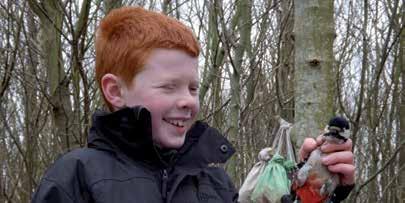
cannot sustain itself; experienced individuals must step up to mentor and support the next generations of ringers, or we risk losing such valuable skills, knowledge, and longrunning data continuity.
There’s a common misconception that bird ringing is outdated or no longer necessary, based on the idea that it was only ever used to solve the mystery of where birds migrate to. While migration studies were one of the earliest and most visible uses of ringing, this view overlooks the immense scientific value that ringing provides today. In fact, now more than ever, ringing is a vital tool for monitoring bird populations in the face of accelerating environmental change. It allows us to collect long-term data on survival rates, breeding success, site fidelity, age structures, and population dynamics. Without it, our ability to track subtle changes in bird populations, whether due to climate change, habitat loss, or disease, would be significantly weakened. Far from being obsolete, ringing remains one of the most essential tools in the conservation toolbox.
It’s hard to believe how quickly time has passed; the years have flown by, shaped by early mornings, mist nets, and the constant thrill of working so closely to wildlife. Looking back, I’m extremely grateful for the opportunities and mentors that helped me get here, and now I feel just as excited looking ahead. Helping to train the next generation of ringers is a privilege I don’t take lightly, and I’m filled with hope for the future knowing there are so many passionate young people out there eager to shape the next chapter of conservation.
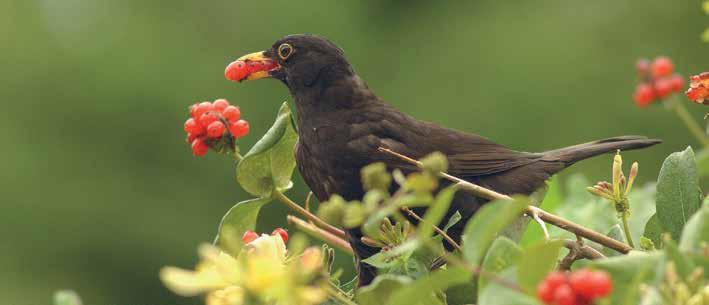
This autumn's bumper berry crop will come as a relief to a species that is potentially being impacted by warmer, drier summers, at a time when they are also being hit by a newly emerging disease.
Blackbirds and Usutu virus
Blackbirds are one of our most ubiquitous species. Their numbers increased sharply between the mid-1990s and mid-2000s, but in recent years the species has declined, particularly in and around London. In this article, Chris du Feu , Trevor Fletcher , Ron Louch and Mike Nicoll share their tips for monitoring Blackbirds, and Rob Robinson and Mel Preston discuss a project that aims to understand more about the causes of the recent declines.
WHY MONITOR BLACKBIRDS?
FURTHER READING
Lawson, B. et al. 2022. Combining host and vector data informs emergence and potential impact of an Usutu virus outbreak in UK wild birds. Scientific Reports 12: 10298.
Robinson, R.A. et al.
2007. Weather-dependent survival: implications of climate change for passerine population processes. Ibis 149: 357–364.
With so many interesting and exciting species out there to monitor, it can sometimes be easy to forget that we also need information about our common species. In the 1970s, the BTO received between 3,000 and 4,000 Blackbird nest records per year. In the past few years, that number has dropped to below 1,000. Ringing totals have also reduced over the past decade. Blackbirds can be subject to various pressures including weather conditions (drought and severe frosts for instance; Robinson et al. 2007) and disease, such as the Usutu virus (see page 18), making monitoring even more important.
FINDING NESTS
Early in the season (late February to mid-April) target evergreen shrubs such as cherry, laurel and Holly, trees with dense ivy cover and evergreen trees such as Yew. Early nesters will use these species as they provide good cover and protection from predators. As the season progresses, nests are often found low down in the ‘crook’ of semi-mature to mature species such as Silver Birch. Nests are often only 30–40 cm
off the ground and can be found anywhere on or near the ground in Bracken, bramble scrub, hedgerows, gorse and so on. Female Blackbirds often sit tight on nests, so if you find a sitting bird, wait for it to leave of its own accord before checking the nest contents, as they can desert if disturbed when incubating. Desertion at chick stage would be more unusual.
TIPS FOR NEST-RECORDING BLACKBIRDS
You will often find nests under construction, or with eggs, in late February. Nests are quite big; with the sun behind you, ‘bulky’ features in a tree often stand out. Sometimes, this will turn out to be just a collection of fallen leaves but often reveals a nest. Looking for features such as a buildup of fresh-looking moss halfway up a tree trunk may also turn out to be a nest site. Walk very slowly around woodland, scrubby woodland edges and hedgerows and check all locations such as the lower limbs of trees. Fallen trees that are lying near horizontal and with ivy cover often hold nests. Adults on or near the nest will often alarm and give the nest location away. When sitting, or nearby a nest, the
adults will give a quiet ‘pipping’ call which indicates a nest is close by. Stopping in a woodland and just waiting can also work well. If a nesting bird is nearby, it will often break from cover and leave the nest, calling loudly and giving the nest location away! Using a stick to tap vegetation can be useful later in the season when vegetation cover is lusher.
Blackbirds will not nest close to each other, but Song Thrush and Blackbird nests are often very close to each other, occasionally even in the same tree, so if you find a Song Thrush, don’t assume there won’t be a Blackbird nesting very close by. Another tip is to go looking for nests in the winter. Although Blackbird don’t usually build in exactly the same location, they often build new nest sites in subsequent seasons nearby, so logging disused nest locations can give a head start in the subsequent breeding season.
BEST PRACTICE
FOR PULLUS RINGING
Blackbird pulli can be ringed up to FS (feathers short) stage, but ringing at six or seven days is ideal. They can be jumpy if approached when too large; if they have head feathers, they are best left unringed. Ring close to the nest and have your ringing gear organised so that time at the nest is minimised.
CATCHING ADULTS
Blackbirds will readily come to bait, meaning they are relatively easy to catch in garden traps, such as Potter traps, drop-door traps or fruit cages. Numbers often peak in February or March as Continental birds start migrating. Using a manually operated trap (either string or electric solenoid to trigger the door) allows you to be selective with what you trap. Blackbirds will come into traps for a variety of bait including fruit, mealworms or crumbled fat balls. In winter, apples are a good bait to use. Traps need to be open and baited all the time to keep the birds coming but, of course, locked open in a safe position when not actively trapping. As with any artificial food source, it is important to consider hygiene and avoid disease transmission by either keeping the ground underneath traps clean or regularly moving traps to new ground.

Two of the three chicks in this nest are at the age where they can start to get jumpy if disturbed in the nest.
CATCHING AT ROOST SITES
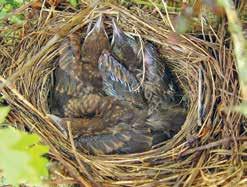
Good numbers of Blackbirds can be caught by mist netting at roost sites. Blackbirds (as well as other species) like to roost in dense clumps of rhododendrons. Love them or hate them, rhododendrons provide a safe, warm and sheltered roost for passerines. The outer layer of dense leaves forms an iglootype canopy, beneath which are hundreds of open perches. The leaves are also strong enough to prevent snow from penetrating. Finches are the first birds to drop into the roost, followed by Blackbirds and finally Robins. The Blackbirds fly in low to the roost, so nets should be set low with deep pockets to hold the birds better.
TRAPS
Details of traps, including the one that proved incredibly successful for Chris du Feu for 40 years (Garden drop-door trap), can be found in the Trapping Guide on the Ringing Hub at: www.bto. org/trapping-guide
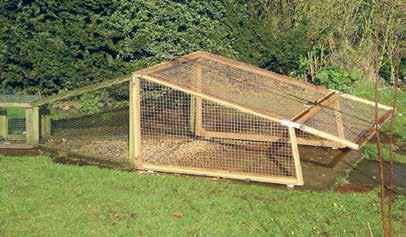
Blackbirds were recorded in almost every 10-km square in the Bird Atlas (2007–11). I’m sure this means when many of you catch a Blackbird you will shrug and say ‘just another Blackbird’, but all data are valuable, even, or especially, from common birds. In fact, many of you in southern England may have noticed there have been fewer Blackbirds around recently.
BTO, in partnership with colleagues from the Animal and Plant Health Agency (APHA), the UK Health Security Agency (UKHSA) and the Institute of Zoology in London are investigating the role of the prime suspect, a mosquito-borne virus, in this decline. Usutu virus was discovered in South Africa as far back as 1959 and first recorded in Europe in 2001 (in Austria). The virus has since been detected in numerous other European countries and, while the precise mechanism for virus spread through mainland Europe is still unknown, it is likely to involve
Participant case study
I am passionately fond of Blackbirds and have had much pleasure and enjoyment in the colour-ringing project that I first became involved with in March 2024. I colour ringed exactly 100 Blackbirds until the end of August, then didn’t see another unringed Blackbird until December, although I had a good number of field sightings. I then proceeded to colour ring a further 14 Blackbirds in December and had many more field sightings. I catch the birds in my garden with two home-made traps which I operate manually so that I can be selective about what I catch. One trap sits on top of a pedestal bird table with the other underneath, screwed to the post. I feed every day throughout the year with suet pellets, sultanas and dry mealworms.
a combination of mosquitoes and migratory birds.
Usutu virus was first detected in Britain, in London, in 2020 (Lawson et al. 2022). In Europe, the virus is known to affect a range of bird species, but Blackbirds and some owls seem to be particularly susceptible, with high levels of mortality being reported where the virus has occurred. And so it has been in Britain. In London and the surrounding area, the number of Blackbirds recorded in both Breeding Bird Survey (BBS) squares and Garden BirdWatch (GBW) gardens has declined markedly.
As part of the investigations, some ringers have been colour ringing Blackbirds to look for changes in survival, whilst others have been taking buccal swab and feather samples to determine how far the virus has spread. The results are currently coming in, but along with parallel sampling of mosquitoes by
This year I have continued to catch and colour ring birds and I am now up to 153 individuals since starting in 2024. In the months up to August 2024 I had a total of 13 juveniles, three of which I have resighted this year. At the time of writing, I have already colour ringed 13 juveniles this breeding season and I still have a month to go, perhaps suggesting that it has been a better year for breeding. I have returned over 500 field sightings since I started the project. Of 19 Blackbirds that I caught and colour ringed between January and March 2025, only three have been resighted in the breeding season, perhaps suggesting that 16 were migrants. It will be interesting to see if any of these 16 birds reappear this winter. Mel Preston
the UKHSA, they suggest that the virus has ‘arrived’ multiple times and is more widespread in England than first thought, which makes the localised reduction in Blackbird numbers in the south-east (so far) all the more remarkable.
The team also has a wider goal. Usutu is part of a family of viruses, the Flaviviridae, that includes West Nile, Dengue and others, which are also spread by mosquitoes and infect birds. While the symptoms of Usutu for infected humans are usually mild (and there have been no reported cases in the UK), others can be much more serious. This project is demonstrating that an integrated approach to monitoring of birds and mosquitoes can be an effective way to track such diseases and hence inform appropriate control measures. Look out for updates in the coming months and, meanwhile, further details can be found at: www. vb-radar.com
Rob Robinson


Urban ringing in Glasgow
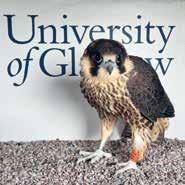
Paul Baker ’s love of birds originated in Liverpool; however, it was in Glasgow that he earned his C permit and embarked on his own ringing projects. The obvious place to start was his tiny tenement garden. A handful of House Sparrows visited daily, or so he thought. Two months later, he had ringed 47 individuals and his urban ringing journey had begun.
I sought permission from the Council to catch in the parks and green spaces across the city, which to my surprise was granted relatively painlessly. Also to my surprise, there was far more variety than I expected, providing many city-based ringing projects. Beginning with a House Sparrow RAS project in my garden, I started colour ringing the city’s gulls and catching passerines on the banks of the River Kelvin, and the list has kept growing.
At first, I didn’t think much about the wider significance of these projects until the University of Glasgow asked me to help with research into how urbanisation affects bird ecology and biodiversity. That invitation set me on a path I hadn’t expected: spending much of my time ringing in public spaces. What follows are some of the experiences, stories, and challenges of urban ringing, and a little advice if you ever feel tempted to try it yourself.
PEOPLE IN THE PARK
The biggest difference between ringing in a remote wood and the city is that there are so many more people around. At first,
I found the interruptions inconvenient; now I see them as opportunities. As the great David Attenborough pointed out, “No one will protect what they don’t care about; and no one will care about what they have never experienced.” The way I see it, my urban ringing sessions could be that first experience.
These impromptu city-based ringing demonstrations differ from those held at nature reserves or organised events, as they reach a completely different group of people, and often people who, for whatever reason, never travel to see nature.
Others are astonished when I show them that the ‘sparrows’ in their gardens are something called Dunnocks or that there are three species of tit in Glasgow. People and their children who might never visit a reserve are genuinely moved by seeing a bird up close and, for some, it’s an encounter they will probably never forget.
UNEXPECTED OUTCOMES
Some projects have led to outcomes I never could have predicted, such as the House Sparrow RAS. A conservation walk, organised for members of the public to

visit the Glasgow RAS colony, was spotted online by a French TV news crew, while preparing a piece on the declining House Sparrow population of Paris. A week later, there we were on the French evening news, looking far too enthusiastic searching for a House Sparrow.
Then there are the University of Glasgow Peregrines. Monitoring falcons nesting on the university tower was exciting enough, but the birds soon became celebrities, appearing on Springwatch and Landward on BBC Scotland.
My own cameo appearances were brief, but these show that small, local projects can have unexpected national and international reach and relevance.
PROBLEMS OF BEING RECOGNISED
Not all recognition is welcome. I’ve now monitored the House Sparrows, Lesser Black-backed Gulls and Black-headed Gulls in Glasgow for over seven years. These long-lived birds are incredibly site faithful; one colour-ringed Black-headed Gull has returned to the same Glasgow Park pond for seven winters, from 2018 to 2024. Many of the birds now know me all too well. The House Sparrows dive into cover at the sight of me; gulls abandon the park ponds when they see nets going up, and many are suspicious even when I come bearing gifts of food. When I tell people of this problem, many suggest I should get a mask; I then ask how long they think it will be before the police are called!
CONSERVATION IN THE CITY
Urban ringing has also drawn me into conservation work. Construction of a new
bridge threatened Sand Martins nesting in the banks of the River Clyde. When I was made aware of this, some polite but persistent enquiries about their mitigation plans for these birds resulted in the developers installing a portable Sand Martin nest bank. It was a reminder that sometimes you can make a difference, and I encourage everyone not to assume someone else will make that call.
Putting up nest boxes is an effective way of increasing the number of birds you can ring in the urban environment. My 100 Tree Sparrow boxes on the north side of the city have now produced over 1,000 chicks during the last five summers. The university, with my help, has erected more than 50 Tawny Owl boxes in and around Glasgow, and many chicks have successfully fledged. A word of warning however if you intend to inspect a box – I’d recommend gloves, goggles and a helmet.
MEMORABLE CATCHES DURING URBAN SESSIONS
Memorable catches are part of the story too. In 2021 at a winter ringing project site, I recaught a Treecreeper that I had ringed six years earlier, making it Scotland’s oldest-known Treecreeper at six years and six months. And on a cold morning in 2020, a Yellow-browed Warbler turned up at the Glasgow vet school, proof that interesting migrants can even appear in the city.
PRACTICALITIES OF RINGING IN THE CITY
Timing matters: artificial light means birds may be active earlier, but parks have opening hours and fill quickly with families. Weekday mornings are best when most people are just passing through on their way to work and school. Weekends start quiet but by mid-morning the park is crowded, and you’d be amazed how many people are drawn to a bush and will come across your nets.
Signs help, but...: I use ropes, notices, even permanent boards at regular sites. Still, some people stroll right past so you must be vigilant and not be far from the nets. I include my mobile number and suggest they call the police if they’re worried.
Diplomacy at the net: people sometimes think I’m rescuing a bird, or that I’m catching them to eat, so you never know
how people will react when you meet them at the net. Keeping calm and staying polite is obviously essential. With luck, after you explain what you are doing they will leave with a positive story to tell their friends.
Pets: dogs off leads can be an expensive visitor to your ringing session when they run through your net. This I know is not unique to urban ringing, but the occurrences can be high. I try to chat with any dog owners in a positive way, and I’ve found that suggesting that a dog may be injured by a net strikes a chord and they will often put the dog on a lead. Cats can also appear in urban gardens, with obvious consequences. Neighbours may be happy to keep them indoors if you ask. I now set nets a metre off the ground, although this comes at the expense of missing the occasional Wren or Dunnock.
Net-pole bag choices: my pole bag has caused stress in several people as it is a camouflage gun bag. Practical but unwise. On one occasion when Nicola Sturgeon (First Minister for Scotland at the time) was visiting a nearby site, a very nervous member of the security team came over to investigate. More recently, I was told that a dog walker had gone to call the police as she had seen ‘a gun in the park’. A brightly coloured bag may be safer, and easier to find when you put it down.
Bring friends: ringing with friends is always a good idea but, in the city, it is extremely important. Just as you’ve found a tangled Wren, someone will want to chat for an hour. Having others on hand ensures birds’ welfare and your own are looked after.
The Police: occasionally a member of the public calls them. This is a great chance to show the Police what a ringing permit looks like, as long as you can find them on your phone. They will also leave knowing more about bird conservation than they ever wanted to!
CONVERSATIONS THAT CHANGE MINDS
Urban ringing is a chance to advocate for the birds by telling their story from their point of view. Gulls are the usual talking point, being described as noisy, messy neighbours.
Many people believe the birds are the same all year round in Glasgow and are
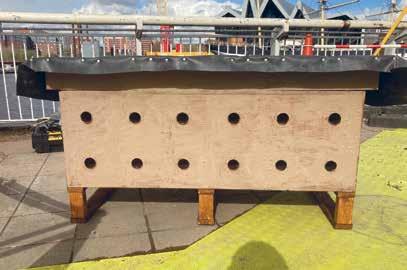
genuinely surprised when you tell them that there may be four different species and that they are migratory; they are not just our gulls, but they are Spain’s, Morocco’s and Mauritania’s gulls. Being able to say “that bird with the green ring came from Sweden” or “the white ring one” was seen on a beach in the Algarve last month does make a difference in how the birds are perceived. I also point out that they eat a lot of rats, so they should be careful what they wish for.
If I am catching tits and other passerines in the parks, the conversation may get onto the topic of how the bird breeding season is going. In response, I discuss the challenges that birds have in urban green spaces in finding enough insects for their chicks and that there is only grass and trees in many of our parks and not enough lower vegetation in between to provide cover from predators, as well as food. I also discuss the importance of native tree species.
CONCLUSION
Urban ringing is not without its challenges, but the benefits far outweigh them; it helps the birds, it contributes to science and perhaps most importantly it connects people with the wildlife in their city. For me it has meant making new friends and hearing very interesting stories, and you spend less time in the car. I hope some of you will take up the challenge.

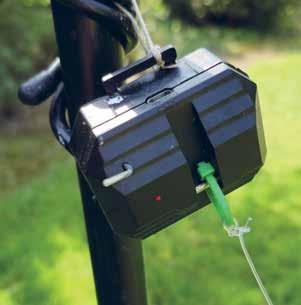
Dropping in
Whether you are working towards a mist-net endorsement, or unable to get out to your usual site because of the weather or access restrictions, the use of conventional traps can make ringing far more accessible. Getting to know your species is key to improving your trap choice and design. In this article, Cheryl Wilson explains how she developed a new trigger for her garden drop trap.
I used a drop trap and Potter trap in my garden last spring and summer and successfully caught Starlings, Blackbirds and other passerines. My Woodpigeons wanted nothing to do with the relatively large Potter trap; however, they couldn’t resist the sunflower hearts used to bait the larger drop trap suspended from my bird feeder. I had a simple string running to just inside the door of my house so the trap could be triggered at the right moment, but I wanted to carry on trapping during the colder autumn and winter months without letting the precious heat out of an open door or window.
There are many ringers who use a car-door locking mechanism for traps and whoosh-net triggers, so I adopted that for my Potter trap. Putting together the trigger required advice from an experienced ringer, the purchasing of components and some trial and error but it did work perfectly to catch the smaller birds who were happily entering for the bait. Unfortunately, the drop trap was just too difficult to make a reliable trigger for using that set-up.
I had come across ‘Drone Droppers’ while I was sourcing the parts for the Potter-trap trigger and could not get it out of my head that it could work for the drop trap. I invested £12 on eBay (other online auction websites are available!) and gave it a try. These droppers are electronic devices that attach to the underneath of a drone and have a small, retractable bar to attach a payload to that requires ‘dropping’. In this case, the payload is a string going from the front edge of the drop trap to the dropper. When the trap is active the bar keeps the front of the drop trap aloft. The remote fob allows me to open the bar from inside the house at the right moment, releasing the string and dropping the trap using gravity.
The range of the remote signal is unlikely to be an issue given the original purpose for these devices. With more help and advice, the trap was improved with weights on the front edge to give that little bit more oomph to the rate of fall, without altering the weight so much that a bird could be injured by the falling trap.
The trap itself is made of what we commonly call Weld Mesh, although that is a trade name. I used a PVCcoated wire mesh (19 gauge/1 mm thick) with 13-mm squares. The size of the mesh can vary, depending on the target species, with larger mesh being less visible. This was cut and formed in such a way as to have no sharp edges on the bottom and is lightweight, no heavier than a hand net.
To add weight, I used metal tent pegs woven into the bottom edges of the Weld Mesh, but you could equally use thicker-gauge wire. The trap is also pegged down at the back edge to prevent larger birds relocating it.
It is a good idea to test drop your trap to make sure it’s working as expected and to understand the footprint of the ‘dropzone’ so you can trigger the dropper when the birds are safely inside. I also have a Ring doorbell camera that I can use to provide line of sight from another angle, ensuring birds are in the right place.
I soon discovered that leaving the dropper attached to the anchor point
on the feeder with a simple piece of string eventually led to the string becoming weathered and failing, so I would definitely recommend bringing the dropper part of the setup in at the end of the session – the devices have no waterproofing that I can see. The trap can then be left to hang directly and securely from the feeder so that the birds become accustomed to feeding beneath it.
As I write this, a pair of Collared Doves who are regular visitors to the garden are heading towards the trap and it is set. Choosing the right moment can be tricky – do I go for one or wait for both and risk getting neither? I went with the one this time, waiting until it was as far into the trap as I dared and …success! Retrieving a bird is easier the larger they are. A hinged flap on the top of the trap can be lifted to gain entry.
An important piece of advice is to make sure you charge the dropper regularly, a fortunate side effect of not leaving the dropper in situ. The problem with using technology rather than a reliable piece of string is the need for power. No-one wants the situation where there is a handsome Jackdaw right inside the trap only for nothing to happen when pressing the remote… (again!).
Bird Observatory focus
SANDWICH BAY BIRD OBSERVATORY
All Bird Observatories have their own individual features and Sandwich Bay is no exception. Apart from being in a bay, rather than on a headland or island, we are also adjacent to centres of population; Sandwich, Deal and Thanet, and not too far from Canterbury. Despite being surrounded by rapidly developing areas, our Recording Area, which includes several of our own reserves managed for a variety of taxa, is protected by three golf courses, a large RSPB reserve and a National Nature Reserve and Ramsar site. Indeed Royal St George’s Golf Club lease us our main ringing site. These two factors give us an enormous opportunity as to what we can offer in terms of education. We are acutely aware that we need to engage the wider population and especially young people with a love and respect for nature if we are to encourage conservation. To this end we employ an Education Officer who is in demand throughout the year, both from local schools and particularly parents during the school holidays. The activities she plans use our reserves and involve the participants where possible in our normal ringing, observing, mothing, and other-taxa activity with the help of
our expert volunteers in their respective fields. One of our ringers has produced a range of knitted birds for the children to ‘ring’. And another of our ringers ‘trains’ our Bay Explorers group in the art of bird ringing. At the other end of the spectrum, we run an annual field week for a local University.
We also run regular birdwatching walks and talks for members and visitors throughout the year plus widening the scope of what we offer to Migration Days (in cooperation with Kent Ornithological Society), a caterpillar ID course (with Butterfly Conservation), Odonata walks, moth and bat evenings, an art course and writers’ courses. A variety of groups both local and from further afield varying from RSPB, WI and U3A make day visits to us and are often led by one of our many volunteers.
Our main focus continues to be monitoring the birds of the Recording Area through ringing and observation. Ringing continues throughout the year with around 6,000 birds ringed annually and, at peak times, our volunteer ringing team aim to operate daily. Our monitoring has recently expanded to include regular ‘noc-mig’ recordings and installing a Motus
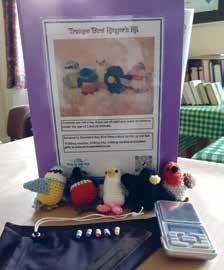
receiving station and these have been turning up much of interest that we would not get any other way. For example, the noc-mig equipment run by an enthusiastic volunteer has picked up migrating Stone-curlew and Night Heron. The Motus station regularly picks up migrating bats and amongst the birds, a Song Thrush that travelled between Denmark, Sandwich Bay, Dungeness, Caistor and back to Germany!
Ian
Hunter, Chair of Trustees and Sally Hunter, Trustee

easily distinguishable
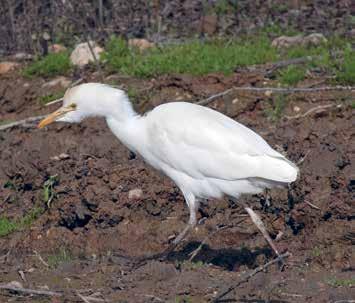
Separating Little and Cattle Egret pulli
In 2024, Merseyside Ringing Group were fortunate enough to have up to 20 breeding-plumaged Cattle Egret regularly visiting their Cormorant and Little Egret colony. They were very hopeful of finding some nests, but couldn’t find any decent information about separating the two species as pulli. Some helpful information was eventually provided by a group who ring them in Spain. Here, Kieran Foster presents some guidance for separating the two species based on the pulli they have ringed.
REGURGITATION
Both species are likely to regurgitate a meal. Little Egrets always tend to smell fishy and contain small fish, or in our case shrimps. Cattle Egret do not smell fishy and contain the remains of flies and beetles.
In early June 2025 we found three Cattle Egret nests very close together (within about six feet), slightly higher than the Little Egrets which were nesting in the same clump of willow. We ended up finding a total of five Cattle Egret nests over the next couple of weeks and managed to ring nine birds (eight pulli). As we were ringing Little Egrets on 12 July, one recently fledged Cattle Egret followed us around as though we were cattle for about 20 minutes, eventually coming close enough for us to catch it. These nine birds became the first wild Cattle Egrets ringed in Britain (one rehabilitated bird was ringed in Cornwall in 2002).
The following information should make separating the two species pretty straightforward, should any other ringers be fortunate enough to have some breeding in a colony near you.
LEGS
The legs of very young Little Egrets are green (Figure 1). As the pulli age, the tarsi get darker. The yellow ‘socks’ generally take a while to appear and the colour of
the feet can be quite variable, but once the tarsi start to darken there is always contrast between the tarsus and the foot. The legs of Cattle Egret are always the same dark colour throughout the length with no contrast between tarsus and foot (Figure 2).
BILL STRUCTURE AND COLOUR
Once Little Egret reach the FS (feathers short) stage, the bill length is obviously greater than half the total head length, whereas for Cattle Egret, the bill length is approximately half the head length. The bill of Little Egret is slender, with Cattle Egret’s looking more robust.
Bill colouration for both species is quite variable, as can be seen from the various photographs in the figures.
The tip of the bill of Cattle Egret is always pale yellow (Figures 3 and 4). This feature has not been observed in any of the 300+ Little Egrets we have ringed in the last few years.
The nares (nasal openings) of Little Egret are long and narrow. In Cattle Egret they tend to be shorter and broader.
IRIS COLOURATION
The iris colour for Cattle Egret is always very pale bluish-white (Figures 4 and 5). The iris colour for Little Egret is variable and does become pale as they near fledging (Figure 6), but generally they are significantly darker, certainly in the first three weeks (Figures 1 and 3).
COLOUR RINGING AND ADDITIONAL BIOMETRICS
There are several individuals and groups colour ringing Little Egrets in Britain and Ireland, with these birds producing many sightings. It is clear that to learn more about the movement and survival of Cattle Egrets breeding in the UK and Ireland, colour ringing is the way forward. As such, a ring colour and position (on the tibia) has been agreed. Little Egret take metal ring size G on the tarsus. Cattle Egret legs are more slender and therefore they take metal ring size Fv~Go on the tarsus. Tibia diameter measurements were taken for the Cattle Egret pulli we ringed and information from ringers on the Continent has been sought but, before the final size of colour rings is agreed by the BTO, we need more tibia measurements. If you are fortunate enough to ring any Cattle Egret pulli, or catch an adult, please record the maximum tibia diameter and submit the data via DemOn.
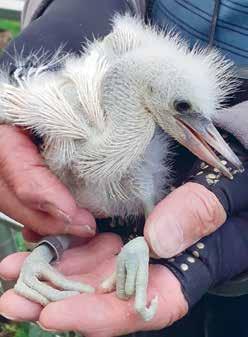

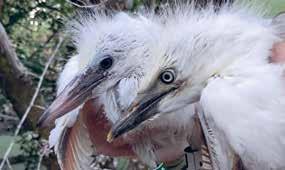
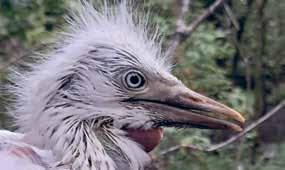

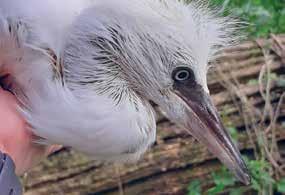

put the ringing world to rights and discuss future ringing and training sessions.
Shropshire Ringing Group
In the second of our series of articles about ringing or nest-recording groups, Peter Jones and Bob Harris introduce the Shropshire Ringing Group. The Group was formed by Gerry Thomas, who recently moved out of the area and left the Group in the capable hands of Peter and Bob. Peter takes up the story…
Just over 10 years ago l crept down a muddy track in the dark to have my first contact with ‘the ringing group’. Many questions raced round my head…Would I be welcomed? Would I enjoy the experience? Would I become a ringer? The answer to all of these questions was ‘yes’.
Accepted as a trainee, I was encouraged by the group and mentored by my Trainer, with everyone being supportive and encouraging; and occasionally being the butt of jokes when mistakes were made (don’t mention the Dunnock). I feel I have been tutored and nurtured in the ‘dark arts’ of ageing and sexing and knowing when to use O or N moult codes with adults and juveniles. Something must have stuck as I now have my S permit and look forward to tutoring others on the regular supply of Yum Yums, Hobnobs, bacon rolls and other essential requisites required by the group during its social, group-ringing sessions; not to mention the ringing!
Shropshire Ringing Group, by any standard, would be considered small.
We have fewer than 20 members, ranging from two Trainers to trainees, with most of our C-permit holders gaining them within the last year.
HOW WE OPERATE
From the outset, the group has operated by consensus, with each member having a voice. Whether discussing the new season’s batch of Redpolls and ‘getting your eye in’ to ageing of woodpeckers, or site selection for the next session, everyone has input, ensuring shared purpose and ownership. C-permit holders are encouraged to run group ringing sessions as soon as they are able, and trainees are encouraged to ring anywhere, anytime to gain experience and to fill areas which the group cannot cover itself – seabirds surprisingly!
Many of our ringing sites are nature reserves, and we have good relationships with Natural England, Wildlife Trusts and Community Groups, all of whom provide volunteers for nest-box checking, survey work, and cutting and maintenance of net rides, typically in exchange for ringing demonstrations
and drop-in visits. In terms of habitat, we have access to woodland and farmland sites (via private landowners), wet and dry scrub, a single reed bed (which is actually just over the border in Staffordshire – reed beds being scant in Shropshire), some upland areas and a series of ponds and wetland habitat. Our ringing totals are not huge, averaging just over 4,000 birds per annum of which c. 600–700 will be pulli; predominantly Pied Flycatcher. Species-wise, we have a list of 104, managing approximately 60 a year. Recently, we have been fortunate to add Hawfinch, Hoopoe and Merlin.
RINGING SESSIONS
Our ringing sessions are more than just handling birds and collecting data. For everything we do we try to add value and punch above our weight. We run several RAS schemes and colourringing projects and also contribute to the Nest Record Scheme. For educational outreach we give lectures and talks, demonstrations and ringing taster sessions. We have also built links
with local universities (Harper Adams, Newport and University of Chester) to provide opportunities for our own research interests as well as providing students with fieldwork and datacollection experience as part of their studies (of which we are preparing two projects for publication).
At the present time, the group has one ‘outing’ a year, when four to eight members have travelled to Scotland for a week’s ringing of Storm Petrels (and skuas, gulls, Shags, Oystercatchers and snipe etc.) in midsummer (a project started by the Bache, Shearwood and McShane partnership, continued by Merseyside RG and now in our hands). Besides being a useful training exercise, it is very much a social event-cumholiday too.
ADMINISTRATION
Administratively, we have an Annual General Meeting covering both the formal (ringing-scheme updates, as well as questioning our own practices) and informal, with members presenting on areas of personal interest or times away. Surprisingly, we have more members than most that take time out to work for BAS on Bird Island Research Station, South Georgia.
As with all groups, member ‘subs’ can be an area of debate. For us, we work on a ‘rings used’ basis. Each member contributes a sum determined by their ringing activity to enable cash flow and a positive bank balance. Periodically, DemOn is made to regurgitate data enabling costs to
Obituary
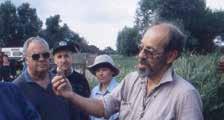
Chris learned to ring at school (Leighton Park). His Trainer was left handed and so Chris ringed left handed even though he was naturally right handed! I first met Chris in late 1968 and within weeks we set out on a trainee/Trainer relationship.
Chris was among a group of six or seven bird ringers who wanted to find a way to contribute to the BTO investigation into Reed and Sedge Warblers and they chose to run a pilot at Wicken Fen in 1968 to determine the feasibility of using the site for that purpose. The following spring, the
pilot having been successful, saw the formation of the Wicken Fen (Bird Ringing) Group. It was called simply the Wicken Fen Group as the original idea was to incorporate the ground censuses etc., not just ringing.
In 1971 Chris took over as the Ringing Secretary and he continued in that role for over 40 years. In the time that he was Ringing Secretary he devoted a great deal of time to logistics: the rota, the equipment, liaising with the National Trust, the accounts and so much more. All while teaching at Cambridge University and in St Catherine’s College.
In that time, he helped to train many new ringers, and this was recognised in 2010 when the BTO awarded him the Jubilee Medal, given to people who have made an outstanding contribution to the work of the BTO. Two aspects of ringing particularly appealed to Chris: first,
be calculated and balances readjusted. One then simply keeps to their ‘determined’ sum by regular payments. Other income is from the talks that we undertake, together with small grants for specific projects, namely nest boxes. And yes, we use social media. We have a Facebook page and use several WhatsApp groups to chat between members but also to maintain contact with all of our landowners.
FINAL THOUGHTS
Although a small group, this works well for us. We know each other well, meet regularly, and can reach consensus on virtually anything in a manner tempered by experience from the elders and blind enthusiasm from the youngsters.
the statistics (he kept a running log of the longevity of each species) and secondly, the training of new ringers as well as adeptly showing the public what bird ringing was about. In addition, Chris kept meticulous records of the birds of Wicken Fen. As well as the topical ones, he also searched back into the past to find sources from as far back as the turn of the 20th century.
He co-authored three editions of The Birds of Wicken Fen, a pamphlet available to visitors. His files of records are now lodged in the Wicken Fen archive. He also assisted for many years with the Catterick Ringing Course.
Chris once said that his ambition was to be the oldest active bird ringer in the UK, which sadly his health did not allow.
This obituary was prepared by Peter Bircham
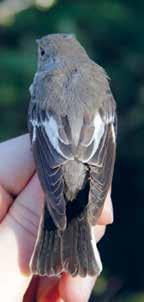
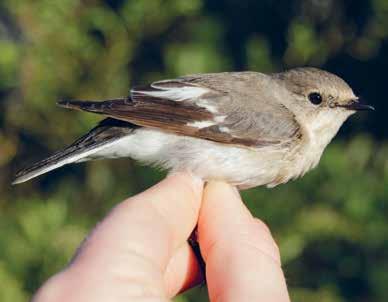
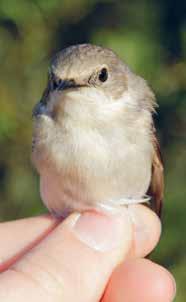
Sweden, May 2012. A standard set of profile photos is a must, showing the bird side-, back- and front-on.
Be prepared for a rare bird
During our usual ringing activities, most of us are unlikely to ever catch a rare bird (as defined by the British Birds Rarities Committee (BBRC) and Irish Rare Birds Committee (IRBC)); however, if you ring in coastal areas or at bird observatories, your chances are much higher. Rare birds can turn up anywhere though, and being prepared for that event is important. In this article, Dawn Balmer , Roger Riddington , Stephen Menzie and Paul French from the BBRC explain what to do if you catch a rare bird.
Imagine the surprise for the ringers at a little thicket on the north side of Thetford in Norfolk on 10 November 2004 when they caught a Grey-cheeked Thrush; the first record for Norfolk! Published ringing guidance makes it clear that ringers are required to submit a description and supporting material to BBRC or IRBC: “To maximise the value of any capture of a rarity, a BBRC/BTO Trapped Rarity Recording Form must be fully completed, including wing formula (where appropriate, as suggested by appropriate identification guides) and all biometrics and sent to the appropriate county recorder and BBRC/IRBC as soon as possible, ideally with photographic evidence.”
SO, WHAT TO DO IF YOU CATCH A RARE BIRD? Nothing is more important than the welfare of the bird; this needs to come first at all times. Time disappears at high speed when dealing with a potential rarity, but taking time to assess the situation at the start will pay dividends later. Depending on how much help
you have, consider furling some or all of your nets. Delegate trusted colleagues to help with identification, processing and, potentially, releasing news and PR duties.
IDENTIFICATION AND PROCESSING
If you are unsure what species you’re dealing with, identification is likely to be the most challenging part of the process. In most cases, you’ll know roughly what you are dealing with, for example a wing-barred Phylloscopus, an unstreaked Acrocephalus, a milkytea Iduna. If you need time to refresh your memory of the key features for identification, consider placing the bird in a clean bird bag while you (and colleagues if you have them) review the literature and determine what the key features are and what you need to measure. The bird will benefit from not being in an increasingly sweaty hand while you go through this process, and it’s generally less stressful for the ringerin-charge as well.
Once you know what species you’re dealing with, or have narrowed down
the possibilities, focus on those key aspects for identification. In addition to the basics (age and sex, wing and weight, potentially fat and muscle too), critical measurements are likely to be some part of a full wing formula, and perhaps also tail and bill measurements; be guided by the literature. For example, if you have a potential Thrush Nightingale you should focus on the length of P1 in relation to primary coverts and a few other key aspects of wing formula, position of P2 and P4, and emarginations. You don’t need to measure the bill and the tail in this case. If you can, delegate someone to have the relevant page of ‘Svensson’ (other guides are available) open while you take the measurements; that person can double-check that all the key measurements are a) taken and b) recorded. If certain measurements are super-critical, have someone else repeat those key biometrics if possible.
Traditionally, in-hand descriptions featured a detailed written description of the entire plumage. By all means do this for key parts of the plumage (so for
that putative Thrush Nightingale, focus on the markings of the head, breast and undertail-coverts, as well as overall colour hues) but it is generally better, and faster, to photograph the key areas.
Finally, don’t forget to preserve any dislodged feathers or faecal matter for potential genetic analysis – which is another good reason for using a clean bird bag.
HOW TO TAKE A PHOTOGRAPH OF A RARITY
Have a plan. Know where you’re going to photograph the bird. Important things to think about are the light conditions and ideally a place out of the wind. Having a plain background can be very useful – some ringing groups and bird observatories are well set up and have a plain (often mid grey) piece of paper pinned up on a wall ready to take photos against. Others like to have a piece of graph paper in the ringing box so that some photos can be taken against that. It’s also important that you feel confident you can take photos in minimal time and without being rushed or pressured.
Know what you’re going to take photos of. Having a clear order of photos will minimise the handling and shifting around time while the bird is in hand.
Ensure the bird is looking comfortable and feathers are smoothed down.
A suggested order of photos might be: wing, spread tail, side-profile, upperparts, underparts, feet/legs and then closeups of important features for the specific bird. For example, if you catch a subalpine warbler, getting a clear photo of the spread tail is important. Finally – practice! When possible, take photos of some of the birds you catch. Practice opening the wing with one hand. Get the process down to as short a time as possible and make it as smooth as possible. You don’t want your first time taking photographs to be with a first for Britain. It’s important to minimise handling time of birds, but having some experience of taking photos may prove useful one day.
RESOURCES
Species and subspecies defined as BBRC and IRBC rarities are found online:
• britishbirds.co.uk/raritiescommittee/rare-birds
• www.irbc.ie/topbar/categories. php
A list of County Recorders can be found at: www.bto.org/learn/ community/county-recorders
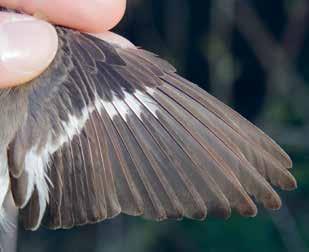
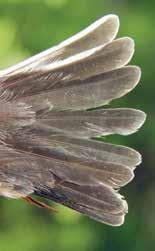
Left: A spread-wing shot, with all of the primaries and secondaries visible, and the ringer’s fingers positioned so that feather tracts such as the primary coverts, alula and greater and median coverts are visible. Right: A spread-tail shot, ensuring that at least all of the tail feathers on one side of the bird’s tail are spread and visible.
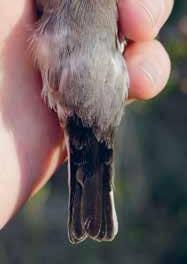
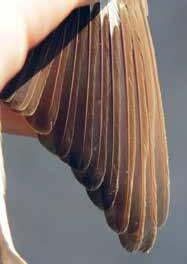
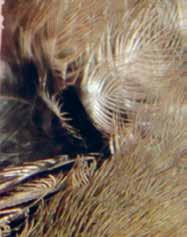
A series of photos showing particular details. Top: the rump; Middle: wing-formula (in addition to showing the moult contrast between the inner and outer primaries in this bird); and bottom: the base of the neck feathers.
Using your data
This feature highlights some of the scientific papers that have been produced using the data that you collect through the Ringing Scheme or the Nest Record Scheme.
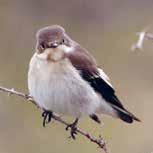
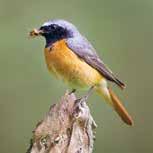
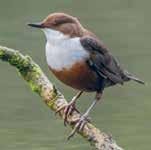
USING CLAW COLOUR TO DETERMINE READINESS FOR RINGING
Pied Flycatcher nestlings have white or pale-pink claws at hatching, and these darken at around four or five days old. Ringers in Somerset have been using the claw colour of Pied Flycatcher pulli as an indicator of readiness for ringing for over 15 years. This study aimed to test the accuracy of this method against other widely used methods such as feather development and age. Ringers who regularly ring Pied Flycatchers in Britain were recruited via Facebook and the Pied Flycatcher Network (piedfly. net) and sent instructions. Records of 1,986 nestlings (1,281 in England and 705 in Wales), monitored during 360 visits to 290 broods between 2021 and 2023, were received and analysed. The results showed that all nestlings with black claws (99.9% of the sample) were large enough to ring. This compared to 99.8% of those at feathers short (FS) stage and 94.6% of those that were at least five days old. Using the FS method of judging readiness to ring would have resulted in 748 nestlings that were large enough to ring, not being ringed as they were still at the in-pin stage (IP). The study concluded that the presence of dark claws is a useful additional criterion for judging whether Pied Flycatcher nestlings in England and Wales are ready to ring.
DO RISING SPRING TEMPERATURES IMPACT REDSTART BREEDING SUCCESS?
Rising temperatures have impacted breeding phenology for many bird species and this can have consequences for their reproductive success. Migratory birds are particularly susceptible to changes in spring temperatures and understanding the impacts of these increases is urgent. This study used over 4,000 nest records, along with spring temperature data from 1974 to 2020, to investigate the impact of spring temperatures on laying date, clutch size and brood size in Redstarts. The study found that higher spring temperatures were associated with earlier egg-laying but had inconsistent impacts on clutch and brood size across space and time. Redstarts were found to advance their laying date by 1–2 days / °C in response to increased temperatures in April and May; however, over the period studied, Redstarts have actually advanced their laying date by 11 days, which is more than would be expected due to temperatures alone. It is possible that the species has further advanced its laying date to track their food resources. The study concluded that warmer springs led to advances in the timing of Redstart egg-laying but found no evidence of costs to reproduction in terms of numbers of chicks fledging.
DOUBLE-BROODING IN DIPPERS
Changes to environmental conditions can lead to advances in the timing of the breeding season, or extended breeding seasons, which may make multi-brooding more common. Understanding what factors affect the likelihood and outcomes of multibrooding is important for predicting population change. This study analysed ringing and nest monitoring data collected in the River Lune catchment, within an 8-km radius of Sedbergh, Cumbria, between 2013 and 2021. The study determined that 29% of Dipper pairs were double brooded, leading to higher reproductive output than single-brooded pairs. The timing of the first brood was the best predictor of a second brood. The results showed that older males were more likely to be double brooded than younger males but didn’t show any effect of female age. Second broods produced fewer eggs and fledged fewer young than first broods. The study showed that the best predictor for breeding success in second broods was the use of a nest box, with the probability of young fledging being almost twice as high if the nest was in a box. This suggests that nestbox provision may be an important conservation tool for this declining species.
Álvarez, N.D. et al. 2025. Seasonal, environmental and individual determinants of double-brooding in the White-throated Dipper (Cinclus cinclus). Ibis, doi: 10.1111/ibi.13439.
Noticeboard
LARGE SPRING TRAPS FOR SALE
One metre square. £160 + carriage. Proven success in catching Marsh Harrier, Buzzard, Red Kite, Great Skua, Sparrowhawk, gulls and more. Netting not supplied but fitting instructions provided. Made to order. Please contact Dave Dutton via: ruth.walker@bto.org
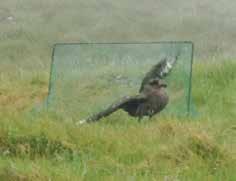
POTTER TRAPS FOR SALE
Two sizes (12” & 16”), also Chardonneret and other traps on request. Please contact John Mawer on 07502 221078 or via email: johnrmawer@hotmail.com
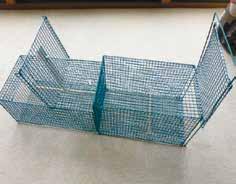
CONTACTS
Nest Record Scheme: nrs@bto.org
Ringing Scheme: ringing@bto.org
Constant Effort Sites: ces@bto.org
Retrapping Adults for Survival: ras@bto.org
Colour ringing: colour.ringing@bto.org
DemOn queries: apps.demon@bto.org
Licensing: ringing.licensing@bto.org
Schedule 1: ringing.schedule1@bto.org
Special Methods: ringing.specialmethods@bto.org
Ringing sales: sales@bto.org
CONFERENCES
Scottish Ringers’ Conference
7–9 November 2025 (Friday evening to Sunday lunchtime)
Location: Carrbridge Hotel, Scottish Highlands
This year’s conference will be hosted by the Highland Ringing Group. See: www.bto.org/our-work/events/scottish-ringers-conference-2025 for more information.
The North of England Raptor Conference
Saturday 15 November 2025
Location: The Glow Venue, Newton Aycliffe, County Durham
The full programme and booking arrangements for delegates are available on the NE Raptor Forum website (https://raptorforum.wordpress.com/ conference/)
Southwest Ringers’ Conference
Saturday 31 January 2026
Location: WWT Slimbridge Wetlands Centre
This event will be hosted and supported by WWT. See https://www.bto.org/ our-work/events/southwest-ringers-conference-2026 for more information.
LICENSING CALENDAR
Jan–Mar — individual ringing permit renewal
Feb — ringing groups renewal
28 Feb — deadline for ringing data from previous year
31 Mar — unrenewed permits expire
May — ring rebates paid
31 Dec — deadline for receipt of Schedule 1 renewals, Special Methods reports, colour-ringing reports and renewals
THE 2025/26 WINTER RINGING PROJECT VISIT PERIODS
1 Saturday 1 November to Friday 14 November
2 Saturday 15 November to Friday 28 November
3 Saturday 29 November to Friday 12 December
4 Saturday 13 December to Friday 26 December
5 Saturday 27 December to Friday 9 January
6 Saturday 10 January to Friday 23 January
7 Saturday 24 January to Friday 6 February
8 Saturday 7 February to Friday 20 February
For more information about the Winter Ringing project, see: https://www.bto.org/get-involved/volunteer/projects/birdringing-scheme/ringing-surveys/winter-ringing-project
Monitoring priorities: Coot
Coot is a common resident and winter visitor in Britain and Ireland but, despite its prevalence, it has historically been insufficiently monitored. Read on to find out how you can assist with efforts to learn more about the British & Irish Coot populations.

CURRENT KNOWLEDGE
Although Coot are found throughout most of Britain and Ireland, with both resident birds and winter visitors a common sight on shallow water bodies, they can be somewhat elusive, especially during the breeding season and, as a result, are under monitored compared to other species. Although populations have seen increases over the long term, there have been some recent population decreases. These are not currently steep enough to be of concern, though they demonstrate the importance of monitoring this species.
HOW CAN YOU HELP?
Colour ringing
The Waterbird Colour-marking Group have been colour ringing Coot since 2008, and have found interesting
insights into their movements. Though rarely seen in flight, it appears that Coot are a relatively wide-ranging species which move around a lot. Although it is common to see Coot on waterbodies with underwater vegetation, which they feed on, they regularly stand on floating vegetation and walk along the banks of water bodies, so metal and colour rings can be read relatively easily. If you have been thinking about having a go at trapping, Coot would be a great species to start with, as they can be caught quite easily in a baited Potter or walk-in trap. If you are interested in colour ringing Coot, please contact colour. ringing@bto.org in the first instance.
Collect nest records
The number of nest records received has sharply decreased, from highs of nearly

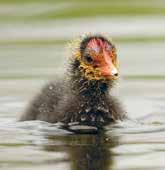
1,000 per year in 2010 to around 200 per year in the past two years. Though somewhat elusive during the breeding season, Coot nests can be found around many water bodies. They are usually found in surrounding vegetation but can also be found on bare reservoirs and even in meadows (though always close to water) where they will use any dead or live vegetation, or even a tree to support the nest. Nests are made up of aquatic grasses and are usually large enough to present little difficulty in finding, if surrounding vegetation is not too dense. They are larger, and have a deeper cup, than Moorhen nests. For some nests, it may be possible to monitor from a distance with a scope or binoculars if it is possible to see into the cup.

Graphs shown are taken from the BTO Trends Explorer (http://data.bto.org/trends_explorer), where results from the Ringing and Nest Record Schemes are published annually, alongside census data. Image by Richard Jackson.
